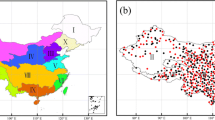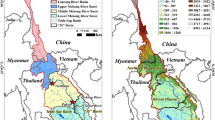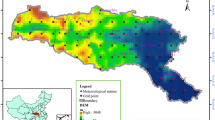Abstract
Precipitation is the most important climate element in supplying Iran’s water resources. Its regular temporal distribution will guarantee the sustainability of water resources. Estimating precipitation behavior in near future will improve managing water resources. Therefore, the current study aimed to examine precipitation regulation in near future (2021–2040). To this end, five models–namely GFDL-ESM4, MPI-ESM1-2-HR, IPSL-CM6A-LR, MRI-ESM2, and UKESM1-0-LL–along with the data of 95 synoptic stations were used. Upon estimating precipitation by the use of these models, the estimated data were ensemble using a multi-model ensemble model, which was based on the correlation-weighted average. Assessing the estimation error indicated the reduction of error rate in the ensemble data. Precipitation concentration index (PCI), precipitation concentration period (PCP), and precipitation concentration degree (PCD) were used to study precipitation regulation in near future. The results suggested more precipitation regulation in the north, northwest, and northeast of Iran, while more precipitation concentration was observed in southern parts of Iran. The precipitation concentration in southern parts of Iran indicates lower precipitation regulation in this area.






Similar content being viewed by others
References
Adegun O, Balogun I, Adeaga O (2012) Precipitation concentration changes in Owerri and Enugu. Special publication of the nigerian association of hydrological sciences 383–391
Alijani B, Brien J, Yarnal B (2008) Spatial analysis of precipitation intensity and concentration in Iran. Theor Appl Climatol 94:P107-124. https://doi.org/10.1007/s00704-007-0344-y
Azizi G, Safarrad T, Mohammadi H, Faraji Sabokbar H (2016) Evaluation and comparison of reanalysis precipitation data in Iran. Phys Geogr Res Q 48(1):33–49. https://doi.org/10.22059/jphgr.2016.57026
Bai H, **ao D, Wang B, Liu DL, Feng P, Tang J (2020) Multi-model ensemble of CMIP6 projections for future extreme climate stress on wheat in the North China plain. Int J Climatol. https://doi.org/10.1002/joc.6674
Benhamrouche A, Boucherf D, Hamadache R, Bendahmane L, Martin-Vide J, Teixeira Nery J (2015) Spatial distribution of the daily precipitation concentration index in Algeria. Nat Hazard 15(3):617–625. https://doi.org/10.5194/nhess-15-617-2015
Benhamrouche A, Martin-Vide J, Pham QB, Kouachi ME, Moreno-Garcia MC (2022) Daily precipitation concentration in Central Coast Vietnam. Theor Appl Climatol. https://doi.org/10.1007/s00704-021-03804-9
Boucher O, Servonnat J, Albright AL, Aumont O, Balkanski Y, Bastrikov V (2020) Presentation and evaluation of the IPSLCM6A- LR climate model. Adv Model Earth Syst 12:e2019MS002010
Caloiero T (2014) Analysis of daily rainfall concentration in new Zealand. Nat Hazards 72:389–404. https://doi.org/10.1007/s11069-013-1015-1
Chang J, Zhang H, Wang Y, Zhang L (2017) Impact of climate change on runoff and uncertainty analysis. Nat Hazards 88:1113–1131. https://doi.org/10.1007/s11069-017-2909-0
Chatterjee S, Khan A, Akbari H, Wang Y (2016) Monotonic trends in spatio-temporal distribution and concentration of monsoon precipitation (1901–2002), West Bengal, India. Atmos Res 182:54–75. https://doi.org/10.1016/j.atmosres.2016.07.010
Cortesi N, González-Hidalgo JC, Brunetti M, Martin-Vide J (2012) Daily precipitation concentration across Europe 1971–2010. Nat Hazards Earth Syst Sci 12(9):2799–2810. https://doi.org/10.5194/nhess-12-2799-2012
Darand M, Khandu K (2020) Statistical evaluation of gridded precipitation datasets using rain gauge observations over Iran. J Arid Environ 178:104172. https://doi.org/10.1016/j.jaridenv.2020.104172
Darand M, Pazhoh F (2022) Spatiotemporal changes in precipitation concentration over Iran during 1962–2019. Clim Change 173:25. https://doi.org/10.1007/s10584-022-03421-z
Fu S, Zhang H, Zhong Q, Chen Q, Liu A, Yang J, Pang J (2023) Spatiotemporal variations of precipitation concentration influenced by large-scale climatic factors and potential links to flood-drought events across China 1958–2019. Atmos Res 282:106507. https://doi.org/10.1016/j.atmosres.2022.106507
Hekmatzadeh AA, Kaboli S, Haghighi AT (2020) New indices for assessing changes in seasons and in timing characteristics of air temperature. Theor Appl Climatol. https://doi.org/10.1007/s00704-020-03156-w
Huang Y, Wang H, **ao WH, Chen LH, Yang H (2019) Spatiotemporal characteristics of precipitation concentration and the possible links of precipitation to monsoons in China from 1960 to 2015. Theor Appl Climatol 138:135–152. https://doi.org/10.1007/s00704-019-02814-y
Kaboli S, Hekmatzadeh AA, Darabi H, Haghighi AT (2021) Variation in physical characteristics of rainfall in Iran, determined using daily rainfall concentration index and monthly rainfall percentage index. Theor Appl Climatol 144:507–520. https://doi.org/10.1007/s00704-021-03553-9
Li X, Jiang F, Li L, Wang G (2011) Spatial and temporal variability of precipitation concentration index, concentration degree and concentration period in **njiang China. Int J Climatol 31(11):1679–1693. https://doi.org/10.1002/joc.2181
Luis M, Gonz’alez- Hidalgo JC, Brunetti M, Longares LA (2011) Precipitation concentration changes in Spain 1946–2005. Nat Hazards Earth Syst Sci 11:1259–1265. https://doi.org/10.5194/nhess-11-1259-2011
Maity SS, Maity R (2022) Changing pattern of intensity-duration-frequency relationship of precipitation due to climate change. Water Resour Manage 36:5371–5399. https://doi.org/10.1007/s11269-022-03313-y
Martin-Vide J (2004) Spatial distribution of a daily precipitation concentration index in peninsular Spain. Int J Climatol A J Royal Meteorol Soc 24(8):959–971. https://doi.org/10.1002/joc.1030
Masoodian SA, Kavyani MR (2008) Climatology of Iran. Isfahan Univercity Press, Isfahan, Iran
Máyer P, Marzol MW, Parreño Castellano JM (2017) Precipitation trends and a daily precipitation concentration index for the mid-eastern Atlantic (Canary Islands, Spain). Cuadernos de Investigación Geográfica. https://doi.org/10.18172/cig.3095
Mendez M, Maathuis B, Hein-Griggs D, Alvarado-Gamboa L-F (2020) Performance evaluation of bias correction methods for climate change monthly precipitation projections over costa rica. Water 12(2):482. https://doi.org/10.3390/w12020482
Mondol MAH, Iqbal M, Jang DH (2018) Precipitation concentration in Bangladesh over different temporal periods. Adv Meteorol. https://doi.org/10.1155/2018/1849050
Müller WA, Jungclaus JH, Mauritsen T, Baehr J, Bittner M, Budich R (2018) A higher-resolution version of the max planck institute earth system model (MPI-ESM1. 2-HR). Adv Model Earth Syst 10(7):1383–1413. https://doi.org/10.1029/2017MS001217
Oliver JE (1980) Monthly precipitation distribution: a comparative index. Prof Geogr 32(3):300–309. https://doi.org/10.1111/j.0033-0124.1980.00300.x
Parajka J, Kohnová S, Bálint G, Barbuc M, Borga M, Claps P, Blöschl G (2010) Seasonal characteristics of flood regimes across the Alpine-Carpathian range. J Hydrol 394(1–2):78–89. https://doi.org/10.1016/j.jhydrol.2010.05.015
Royé D, Martin-Vide J (2017) Concentration of daily precipitation in the contiguous United States. Atmos Res 196:237–247. https://doi.org/10.1016/j.atmosres.2017.06.011
Sarricolea P, Meseguer-Ruiz Ó, Serrano-Notivoli R, Soto MV, Martin-Vide J (2019) Trends of daily precipitation concentration in Central-Southern Chile. Atmos Res 215:85–98. https://doi.org/10.1016/j.atmosres.2018.09.005
Sellar AA, Walton J, Jones CG, Wood R, Abraham NL, Andrejczuk M (2020) Implementation of UK Earth system models for CMIP6. Adv Model Earth Syst 12(4):e2019MS001946
Sentman LT, Dunne JP, Stouffer RJ, Krasting JP, Toggweiler JR, Broccoli J (2018) The mechanistic role of the central American seaway in a GFDL earth system model. Part 1: impacts on global ocean mean state and circulation. Paleoclimatology 33(7):840–859. https://doi.org/10.1029/2018PA003364
Shi P, Wu M, Qu S, Jiang P, Qiao X, Chen X, Zhang Z (2015) Spatial distribution and temporal trends in precipitation concentration indices for the Southwest China. Water Resour Manag 29:3941–3955. https://doi.org/10.1007/s11269-015-1038-3
Singh G, Panda RK, Nair A (2020) Regional scale trend and variability of rainfall pattern over agro-climatic zones in the Mid-Mahanadi River basin of eastern India. J Hydro Environ Res 29:5–19. https://doi.org/10.1016/j.jher.2019.11.001
Valli M, Sree KS, Krishna IVM (2013) Analysis of precipitation concentration index and rainfall prediction in various agro-climatic zones of Andhra Pradesh India. Int Res J Environ Sci 2(5):53–61
Vyshkvarkova E, Voskresenskaya E, Martin-Vide J (2018) Spatial distribution of the daily precipitation concentration index in Southern Russia. Atmos Res 203:36–43. https://doi.org/10.1016/j.atmosres.2017.12.003
Wang S, Cao Z, Luo P, Zhu W (2022) Spatiotemporal variations and climatological trends in precipitation indices in Shaanxi Province China. Atmos 13(5):744. https://doi.org/10.3390/atmos13050744
Wehner M (2013) Very extreme seasonal precipitation in the NARCCAP ensemble: model performance and projections. Clim Dyn 40(1):59–80. https://doi.org/10.1007/s00382-012-1393-1
Yin Y, Xu CY, Chen H, Li L, Xu H, Li H, Jain SK (2016) Trend and concentration characteristics of precipitation and related climatic teleconnections from 1982 to 2010 in the Beas River basin, India. Global Planet Change 145:116–129. https://doi.org/10.1016/j.gloplacha.2016.08.011
Zamani R, Mirabbasi R, Nazeri M, Meshram SG, Ahmadi F (2018) Spatio-temporal analysis of daily, seasonal and annual precipitation concentration in Jharkhand state, India. Stoch Environ Res Risk Assess 32:1085–1097. https://doi.org/10.1007/s00477-017-1447-3
Zarrin A, Dadashi-Roudbari A (2022) Projection of precipitation intensity in Iran using NEX-GDDP by multi-model ensemble approach. Iran J Geophys 16(1):47–68. https://doi.org/10.30499/ijg.2021.300366.1353
Zhai P, Zhang X, Wan H, Pan X (2005) Trends in total precipitation and frequency of daily precipitation extremes over China. J Clim 18(7):1096–1108. https://doi.org/10.1175/JCLI-3318.1
Zhang LJ, Qian YP (2003) Annual distribution features of precipitation in China and their interannual variations. Acta Meteor Sin 2:146–163
Zhang K, Yao Y, Qian X, Wang J (2019) Various characteristics of precipitation concentration index and its cause analysis in China between 1960 and 2016. Int J Climatol 39(12):4648–4658. https://doi.org/10.1002/joc.6092
Zhao Q, Liu S, Deng L, Dong S, Yang J, Wang C (2012) The effects of dam construction and precipitation variability on hydrologic alteration in the Lancang river basin of Southwest China. Stoch Env Res Risk A 26:993–101. https://doi.org/10.1007/s00477-012-0583-z
Zhao CC, Yao SX, Li QF (2019) Characteristic of precipitation concentration index in Qilan mountains, Northwest China. IOP Conf Ser Earth Environ Sci 344(1):012105. https://doi.org/10.1088/1755-1315/344/1/012105
Zhu Y, Yang S (2020) Evaluation of CMIP6 for historical temperature and precipitation over the Tibetan Plateau and its comparison with CMIP5. Adv Clim Change Res 11(3):239–251. https://doi.org/10.1016/j.accre.2020.08.001
Zubieta Barragán R, Saavedra Huanca M, Silva Vidal Y, Giráldez L (2017) Spatial analysis and temporal trends of daily precipitation concentration in the Mantaro River basin: central Andes of Peru. https://doi.org/10.1007/s00477-016-1235-5
Acknowledgments
The authors thank the Iran National Science Foundation (INSF) to support this article (n. 4003254). The data on daily precipitation were provided by the Islamic Republic of Iran Meteorological Organization (IRIMO), which has been described in detail under the heading “data” in this manuscript. The data are available in case of a reasonable request by conducting the corresponding author.
Funding
The authors declare that no funds, grants, or other support were received during the preparation of this manuscript.
Author information
Authors and Affiliations
Contributions
All authors contributed to the study conception and design. Material preparation, data collection and analysis were performed by [SA], [ARK] and [MK]. The first draft of the manuscript was written by [MK] and all authors commented on previous versions of the manuscript. All authors read and approved the final manuscript.
Corresponding author
Ethics declarations
Conflict of interest
The authors have no relevant financial or non-financial interests to disclose.
Additional information
Publisher's Note
Springer Nature remains neutral with regard to jurisdictional claims in published maps and institutional affiliations.
Rights and permissions
Springer Nature or its licensor (e.g. a society or other partner) holds exclusive rights to this article under a publishing agreement with the author(s) or other rightsholder(s); author self-archiving of the accepted manuscript version of this article is solely governed by the terms of such publishing agreement and applicable law.
About this article
Cite this article
Ashrafi, S., Karbalaee, A.R. & Kamangar, M. Projections patterns of precipitation concentration under climate change scenarios. Nat Hazards 120, 4775–4788 (2024). https://doi.org/10.1007/s11069-024-06403-9
Received:
Accepted:
Published:
Issue Date:
DOI: https://doi.org/10.1007/s11069-024-06403-9




